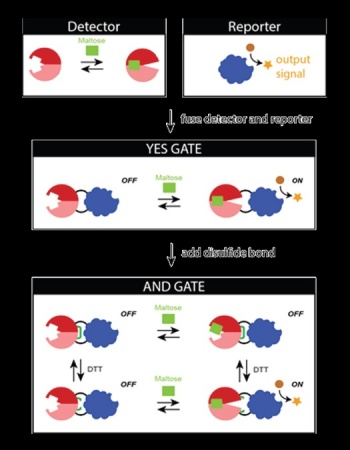Opening the (Protein Logic) Gates
Researchers at Johns Hopkins University have found a way to engineer protein logic gates that sense, identify, and report on the presence of infectious agents without causing harm to the warfighter.

AND logic gate design and function – The protein AND logic gate was built from a protein that bound maltose (the detector) and an enzyme that catalyzed a reaction (the reporter), which causes a color change in the solution or causes the bacteria to behave in a certain fashion.
This basic research effort, managed by DTRA CB/JSTO’s Dr. Ilya Elashvili and performed by Johns Hopkins University’s Drs. Jay H. Choi and Marc Ostermeier, describes proof of principle experiments that demonstrates the successful design of artificial fusion proteins that function as protein logic gates. The introduction of these proteins into cells resulted in cells with the desired logic gate function.
Eventually, researchers hope to create autonomously functioning cells that would seek and destroy pathogens and possibly diagnose and cure maladies that could affect warfighters.
Synthetic biology seeks to build programmed cells that respond to molecular signals with a desired behavior. Two-input logic gates are a fundamental unit of decision-making and thus have been a focal point for building programmed cells from the ground up.
With a few notable exceptions, the predominant focus in synthetic biology has been on building transcriptional network logic gates that function on the DNA level, which are then combined to build more complex behavior. However, conceptually, protein logic gates offer advantages of simplicity, speed and reduced consumption of cellular resources.
The recent ACS Synthetic Biology article, “Rational Design of a Fusion Protein to Exhibit Disulfide-Mediated Logic Gate Behavior,” describes the redesign of a single protein (RG13) to have different logic gate and toggling functionalities. RG13 is a fusion of maltose binding protein and TEM-1 beta-lactamase for which maltose is a positive activator of beta-lactamase enzyme activity.
By the proper introduction of a disulfide bond into RG13 that prevents enzyme activation, a protein that functions as an AND logic gate was created. The AND gate required both maltose and a reducing agent (which breaks the disulfide bond) for activation of enzyme activity.
Through the proper introduction of mutations at other locations, the researchers also created a version of RG13 that was activated by reducing agents and not maltose, and a version that was activated by the absence of reducing agent or the presence of maltose (a logic gate known as ORN).
The complexity of proteins and generally their relative lack of modularity (compared to gene networks) are significant impediments to the realization of proteins’ potential as logic gates that rival transcriptional networks. However, this research establishes that protein logic gates of different types can – in principle – be built in a rational fashion using protein modules.
This basic research is part of a gradual development of a toolbox of sensing and treatment options, including creating a viable system of autonomously functioning cells to sense, diagnose and even cure harmful agents affecting the warfighters.
Source: U.S. Department of Defense Armed with Science
- 271 reads
Human Rights
Ringing FOWPAL’s Peace Bell for the World:Nobel Peace Prize Laureates’ Visions and Actions

Protecting the World’s Cultural Diversity for a Sustainable Future

The Peace Bell Resonates at the 27th Eurasian Economic Summit

Declaration of World Day of the Power of Hope Endorsed by People in 158 Nations

Puppet Show I International Friendship Day 2020

